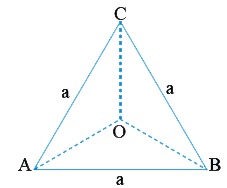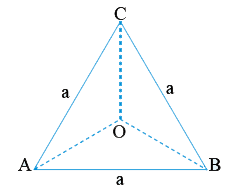Given an equilateral triangle ABC with side length equal to 'a'. Let M and N be two points respectivelyАВIn the side AB and AC such that −−→AN=K−−→ACand−−→AM=−−→AB3 If −−→BNand−−→CM are orthogonalthen the value of K is equal to
15
14
13
12
The correct Answer is:A
To solve the problem, we need to determine the value of K given the conditions of the equilateral triangle ABC and the points M and N on sides AB and AC respectively.
1. Define the Position Vectors:
Let the position vectors of points A, B, and C be represented as:
→A=→0,→B=→a,→C=→a(12,√32)
Here, →B is at (a,0) and →C is at (a2,a√32).
2. Determine Points M and N:
- Point M on AB:
→M=13→B=13→a
- Point N on AC:
→N=K→C=K(a2,a√32)
3. Vectors →BN and →CM:
- The vector →BN:
→BN=→N−→B=K(a2,a√32)−→a=(Ka2−a,Ka√32)
- The vector →CM:
→CM=→M−→C=13→a−(a2,a√32)=(13a−a2,13⋅0−a√32)
4. Set Up the Orthogonality Condition:
The vectors →BN and →CM are orthogonal, so their dot product is zero:
→BN⋅→CM=0
5. Calculate the Dot Product:
(Ka2−a)(13a−a2)+(Ka√32)(−a√32)=0
6. Simplify the Equation:
- The first term simplifies to:
(Ka2−a)(13a−a2)=(Ka−2a2)(2−36a)=(Ka−2a2)(−a6)
- The second term simplifies to:
−Ka2⋅34=−3Ka24
7. Combine and Solve for K:
Set the combined equation to zero and solve for K:
(Ka−2a2)(−a6)−3Ka24=0
8. Final Calculation:
After simplifying and solving, we find:
K=15
Conclusion:
The value of K is 15.
Let the position vectors of points A, B, and C be represented as:
→A=→0,→B=→a,→C=→a(12,√32)
Here, →B is at (a,0) and →C is at (a2,a√32).
- Point M on AB:
→M=13→B=13→a
- Point N on AC:
→N=K→C=K(a2,a√32)
- The vector →BN:
→BN=→N−→B=K(a2,a√32)−→a=(Ka2−a,Ka√32)
- The vector →CM:
→CM=→M−→C=13→a−(a2,a√32)=(13a−a2,13⋅0−a√32)
The vectors →BN and →CM are orthogonal, so their dot product is zero:
→BN⋅→CM=0
(Ka2−a)(13a−a2)+(Ka√32)(−a√32)=0
- The first term simplifies to:
(Ka2−a)(13a−a2)=(Ka−2a2)(2−36a)=(Ka−2a2)(−a6)
- The second term simplifies to:
−Ka2⋅34=−3Ka24
Set the combined equation to zero and solve for K:
(Ka−2a2)(−a6)−3Ka24=0
After simplifying and solving, we find:
K=15
The value of K is 15.
Topper's Solved these Questions
- PRODUCT OF VECTORSBOOK - ARIHANT MATHS ENGLISHCHAPTER - PRODUCT OF VECTORSEXERCISE - Exercise (More Than One Correct Option Type Questions)
35 Videos
- PRODUCT OF VECTORSBOOK - ARIHANT MATHS ENGLISHCHAPTER - PRODUCT OF VECTORSEXERCISE - Exercise (Statement I And Ii Type Questions)
12 Videos
- PRODUCT OF VECTORSBOOK - ARIHANT MATHS ENGLISHCHAPTER - PRODUCT OF VECTORSEXERCISE - Exercise For Session 4
10 Videos
- PROBABILITYBOOK - ARIHANT MATHS ENGLISHCHAPTER - PROBABILITYEXERCISE - Exercise (Questions Asked In Previous 13 Years Exam)
54 Videos
- PROPERTIES AND SOLUTION OF TRIANGLES BOOK - ARIHANT MATHS ENGLISHCHAPTER - PROPERTIES AND SOLUTION OF TRIANGLES EXERCISE - Exercise (Questions Asked In Previous 13 Years Exam)
21 Videos
Similar Questions
Knowledge Check
If OACB is a parallelogrma with −−→OC=→a and −−→AB=→b then −−→OA is equal to
A→a+→bB→a−→bC12→a−→bD12→a−→b
If ABCDEF is a regular hexagon, prove that −−→AC+−−→AD+−−→EA+−−→FA=3−−→AB
View SolutionE and F are the interior points on the sides BC and CD of a parallelogram ABCD. Let −−→BE=4−−→ECand−−→CF=4−−→FD. If the line EF meets the diagonal AC in G, then −−→AG=λ−−→AC, where λ is equal to :
View SolutionIf a and b are position vectors of A and B respectively the position vector of a point C on AB produced such that −−→AC=3−−→AB is
View SolutionABC is an equilateral triangle. Length of each side is 'a' and centroid is point O. Find

If −−→AB+−−→AC=n−−→AO then n = ?
View SolutionABC is an equilateral triangle. Length of each side is 'a' and centroid is point O. Find

−−→AB+−−→BC+−−→CA
View SolutionIf D,E and F are the mid-points of the sides BC, CA and AB respectively of a triangle ABC and λ is scalar, such that −−→AD+23−−→BE+13−−→CF=λ−−→AC, then λ is equal to
View SolutionGiven a parallelogram ABCD. If ∣∣∣−−→AB∣∣∣=a,∣∣∣−−→AD∣∣∣=b&∣∣∣−−→AC∣∣∣=c , then −−→DB.−−→AB has the value
View Solution
